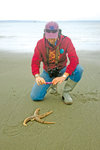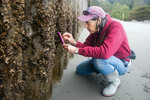Though the day started out with gray skies and brisk winds, volunteers turned out by the dozens to the Port Townsend Marine Science Center on the morning of April 20 for the annual Earth Day Beach Cleanup and BioBlitz.
This item is available in full to subscribers.
We have recently launched a new and improved website. To continue reading, you will need to either log into your subscriber account, or purchase a new subscription.
If you had an active account on our previous website, then you have an account here. Simply reset your password to regain access to your account.
If you did not have an account on our previous website, but are a current print subscriber, click here to set up your website account.
Otherwise, click here to view your options for subscribing.
* Having trouble? Call our circulation department at 360-385-2900, or email our support.
Please log in to continue |
|


Though the day started out with gray skies and brisk winds, volunteers turned out by the dozens to the Port Townsend Marine Science Center on the morning of April 20 for the annual Earth Day Beach Cleanup and BioBlitz.
Michael Siddel, one of four AmeriCorps volunteers at the Marine Science Center, helped coordinate volunteers looking to do some “citizen science” by helping them download the iNaturalist app, so they could record all the different types of plants and animals they saw at Fort Worden.
By 10 a.m., only half an hour after the volunteers first met and were sent out into Fort Worden, they’d posted 44 observation photos online.
“That project page is accessible online, so that other people can join in helping to identify the species of plants and animals that are photographed,” Siddel said. “It’s crowdsourcing the knowledge base, as we take a snapshot of as many species as we can find on this particular day.”
Especially since it’s only their second year of using iNaturalist, Siddel declined to say whether the volunteers’ observations could be used to track the waxing or waning of any species’ population at Fort Worden, but he did appreciate seeing younger volunteers such as the Port Townsend High School biology students taking part, especially since they’d photographed 20 different species by 10 a.m.
Toni Davison already volunteers as a docent at the Marine Science Center Museum, but hastened to add she’s “not a naturalist by trade.”
Nonetheless, Davison managed to identify no less than 28 different species last year, even though she stuck almost exclusively to the beach.
“The pilings are good places to find different species, from barnacles and limpets to crabs and chitons,” Davison said. “You have to really look, because a lot of them blend into their surroundings. I haven’t seen any anemones yet this year, but I’ve seen some birds, and a river otter, but I couldn’t get a photo of that one.”
Davison appreciates the work the Marine Science Center does to protect the Salish Sea environment, and believes an essential next step is to instill an awareness and sense of responsibility in others to help do the same.
“When you do citizen science like this, you learn to see what you hadn’t seen before,” Davison said. “It makes walking on the beach more fun, and when people do that, they also wind up saying to themselves, ‘We need to be sure to keep all these species around.’”
A lifelong nature enthusiast even during her years in Colorado, Davison saw retirement as an opportunity to treat herself to a different environment by moving to the Pacific Northwest, and she described her time in Port Townsend in particular as “outstanding.”
While Davison was studying the flora and fauna of the beach, Neal Heimer was doing his best to make sure their habitat retained habitable, by picking up trash off the coastline.
For the most part, Heimer found the beaches of Fort Worden relatively pristine, aside from pieces of plastic bags and plywood.
“I moved here from Whidbey Island when I retired, and I think Fort Worden is just a wonderful resource, so I’m doing what I can to keep it this way,” said Heimer, as he placed some two-by-fours in his collection bin. “I’m not a biologist, but I don’t think treated wood is good for a beach.”
Marley Loomis, another of the AmeriCorps volunteers, explained that the Marine Science Center had partnered with Washington CoastSavers to send volunteers to clean the beaches at the Fort Worden, Fort Flagler and Fort Townsend State Parks, as well as Chetzemoka Park and North Beach.
Just as Siddel estimated his portion of the event had drawn roughly two dozen citizen scientists, so too did Loomis count more than 50 beach cleaners on her signup sheet.
“You see a lot of depressing news about pollution and marine debris,” Loomis said. “It can feel overwhelming, but by doing something, even if it’s just a little something, you know you’ve had a positive impact, so you can feel hopeful rather than defeated.”
Last year’s beach cleanups for Earth Day yielded 263 pounds of refuse, much of it recyclable, while this year’s total was 492 pounds.
In addition to collecting trash, volunteers also help CoastSavers collect data on waste at beaches, that’s shared as part of an international database.